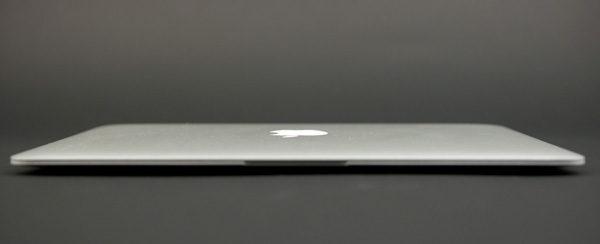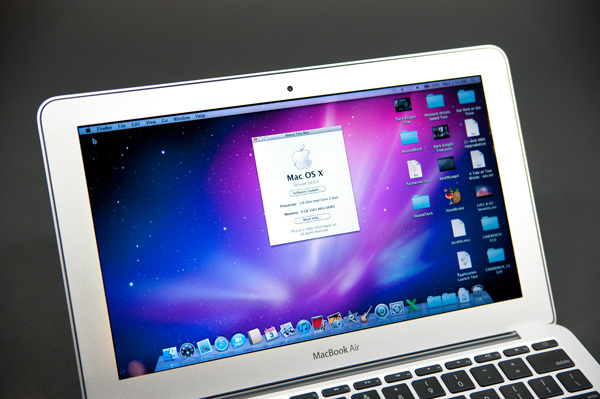Apple's 11-inch Upgraded MacBook Air: Do 1.6GHz and 4GB Make a Difference?
by Anand Lal Shimpi on November 6, 2010 2:35 AM EST- Posted in
- Mac
- Apple
- MacBook Air
- Laptops
Last month we looked at Apple’s new 11-inch and 13-inch MacBook Airs. I concluded the 11-inch was the pinnacle of portability, delivering the weight and form factor of a netbook but without the drive-you-crazy performance of an Atom. The 13-inch was more of a regular, get-your-work done notebook - just in a very thin and very light chassis. I liked carrying the 11-inch MBA, but I liked working on the 13-inch. My typical workflow was simply too slow on the 1.4GHz 11-inch system.
Apple offers two potentially important upgrades for the 11-inch MacBook Air that could alleviate some of my concerns. For $100 more than its $999 starting price, you can outfit the 11 with 4GB of memory instead of 2GB. Light web browsing and writing don’t need more than 2GB, but start editing videos, photos or open way too many apps at once and you’ll quickly want more memory. If you’re planning on keeping your system for a while, the 4GB upgrade makes a lot of sense. And many Apple stores actually stock the upgraded 4GB model.
The next upgrade is a bit harder to swallow. The base 11-inch MacBook Air can’t be upgraded aside from memory. The $1199 model however, can. You get a 128GB SSD (up from 64GB) as well as the option to pay $100 for a 1.6GHz Core 2 Duo.
Normally 200MHz isn’t much to write home about, especially not for $300 more than the standard 11. However, 200MHz is a 14% increase in clock speed compared to the base model. In applications that are CPU bound, you may see close to that percentage in improved performance. The magic number for feeling a performance increase is 10%. Anything below that is tough to feel in real world use, but anything at or above that 10% mark usually feels quicker.
| MacBook Air Spec Comparison | |||||
| 11-inch | Upgraded 11-inch | 13-inch | |||
| CPU | Intel Core 2 Duo 1.4GHz | Intel Core 2 Duo 1.6GHz | Intel Core 2 Duo 1.86GHz (2.13GHz optional) | ||
| Memory | 2GB DDR3-1066 soldered on-board | 4GB DDR3-1066 soldered on-board | 2GB DDR3-1066 soldered on-board (4GB optional) | ||
| GPU | NVIDIA GeForce 320M | NVIDIA GeForce 320M | NVIDIA GeForce 320M | ||
| Storage | 64GB SSD | 128GB SSD | 128GB SSD (256GB optional) | ||
| Connectivity | 802.11a/b/g/n Bluetooth 2.1 + EDR | 802.11a/b/g/n Bluetooth 2.1 + EDR | 802.11a/b/g/n Bluetooth 2.1 + EDR | ||
| Battery Capacity | 35 Whr | 35 Whr | 50 Whr | ||
| Dimensions | 11.8 " x 7.56 " x 0.11 - 0.68" (29.95 cm x 19.2 cm x 0.3 - 1.7 cm) |
11.8 " x 7.56 " x 0.11 - 0.68" (29.95 cm x 19.2 cm x 0.3 - 1.7 cm) |
12.8 " x 8.94 " x 0.11 - 0.68" (32.5 cm x 22.7 cm x 0.3 - 1.7 cm) |
||
| Weight | 2.3 lbs (1.06 kg) | 2.3 lbs (1.06 kg) | 2.9 lbs (1.32 kg) | ||
| Price | $999 | $1399 | $1299 | ||
Combine the two upgrades and you’ve got a fairly expensive MacBook Air ($1399 if you’re keeping score). But if you want the portability of the 11 and are looking to get as much performance as possible, it’s your only option.
Luckily we happened to come across such a system. And we didn’t hesitate to test it.












85 Comments
View All Comments
sprockkets - Saturday, November 6, 2010 - link
Yes, and I'm sure you have 3 different web sites open with 1-4 flash animations all the time?HTML5 animations are a power hog too. No such thing as a free lunch.
DanielATMD - Saturday, November 6, 2010 - link
Very good review.$1400 is a lot for many. But if one is going to use their computer to generate income, each model and is well worth serious consideration and should be spec'd accordingly.
Anand, I would be interested in how the MacBook Airs functions connected to a Apple Cinema Display or any other 27-30 monitor.
Right now, I have my MacBook Pro 15" connected to a 24 and a 28.5 inch LCD's, and am very interested in the MBA 11 for traveling.
Thank you.
pixelhaus - Saturday, November 6, 2010 - link
Ars Technica covered the part about using the new MBA with Apple's current 27-inch Cinema Display, it works just fine. The only weird bit is having to stretch the 3-way split cable for mini-DisplayPort, USB and MagSafe power connector; the power connector and mini-DisplayPort are on opposing sides of the MBA.Ronin48 - Saturday, November 6, 2010 - link
Can you please add a 1.4GHz 11" MacBook Air 4GB machine to this comparison?And the 1,6GHz with only 2GB RAM as well?
It would be really interesting to see how these middle-spec CTO units compare to the 1.4GHz 2GB base unit and the 1.6GHz 4GB ultimate unit that you compared here.
It's likely that one of the middle-spec units is the best performance/price/battery combination don't you think?
nitrousoxide - Saturday, November 6, 2010 - link
First I agree that this upgrade makes significant improvement compared to factory configurations, Anand gives us convincing results. It is a good deal compared to an MBA 11-inch by default, but what if compared to an MBA 13-inch which ships with a much faster CPU but $200 cheaper? Does 300 grams of weight really makes any difference in portability? Perhaps Anand is too focused on specific data, but not actual using experience. I currently use an MBA 13-inch and a SONY VAIO EA, 1.3kg and 2.3kg are exactly two different things, the MBA allows me to pack more learning material into my backpack when going to classes everyday so I just use the VAIO with i7 and discrete GPU as workstation. 1.0kg and 1.3kg, however, isn't that different, that's what I feel when I borrowed an MBA 11-inch from my friend and try to compare it to mine.blandead - Saturday, November 6, 2010 - link
you also have to remember this is for people who use macs. they are used to paying up the ass for upgrade or anything so they would know better if this is a good upgrade or not when you stay within the mac world.if you use a PC and not Mac as a majority don't even try to think what makes more sense, they don't care about $400 extra when they buy $600 ipad
hate macs....
solipsism - Saturday, November 6, 2010 - link
It’s funny that you imply the iPad expensive when all the other vendors had to go back to the drawing board and are trying desperately to match the iPad’s price point with a clearly cheaper device.khimera2000 - Sunday, November 7, 2010 - link
It takes years to divelop a product. apple just had a bigger splash with less horse power and a bigger price tag. if we wanted to match apples price point then all we have to do is put it up against a cheap android tablet. IPad and IPhone are vary simmilar in performance.it actualy looks like a step backwords in my eyes since ive seen tablet like devices in the past theres is nothing impressive about this divice. If they found a way to use a colored digital ink display in the divice then that would be intresting since it can be seen in direct sun light... near any direct sunlight.
If other companies wanted to match ipad's performance they would most certainly have to downgrade all there hardware across the board (at least for the windwos based ones)
if i where to get a tablet then it would probably be the new dell system that has a flip screen, at least then i can do work.
sprockkets - Saturday, November 6, 2010 - link
"At $1399 there's almost no way to rationally justify the price and rest assured that within 12 - 18 months Apple will have a thinner version available, likely at the same price point."T,FTFY
tehjord - Saturday, November 6, 2010 - link
Can't you overclock the 1.4ghz cpu to 1.6ghz or even more if it's safe. I mean, isn't the 1.4ghz cpu the same as the 1.6ghz cpu?So if you actually do need that extra 200mhz, just oc for the time of your workload?